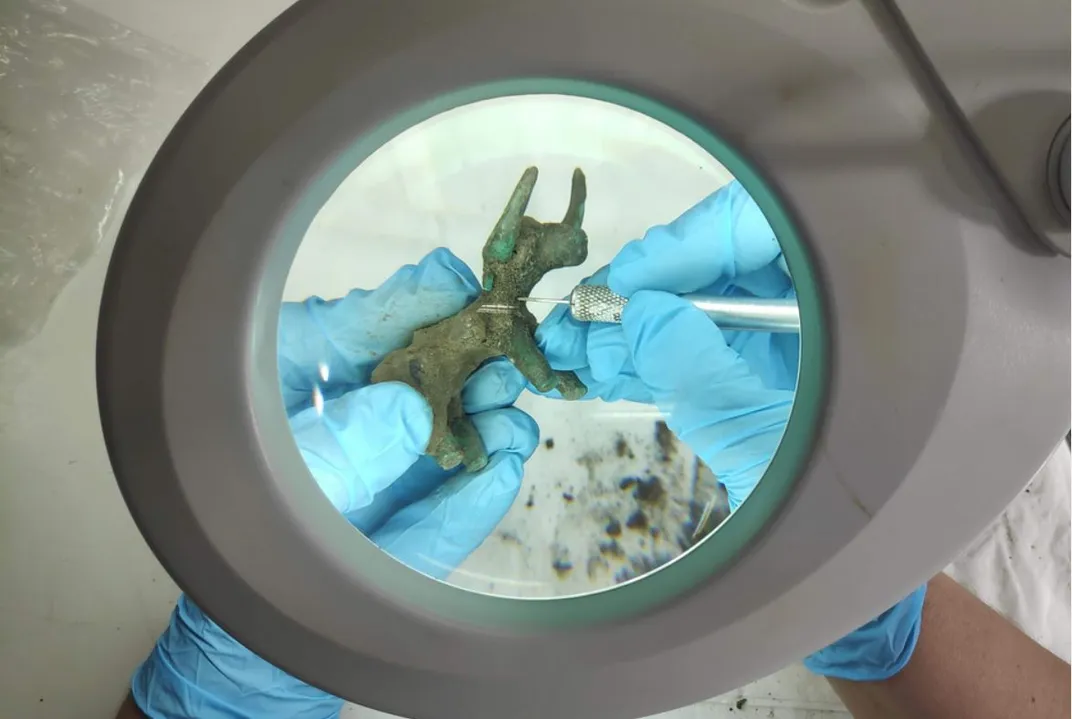Rare Bronze Bull Sacrificed to Zeus Found at Site of the Ancient Olympic Games
The 3,000-year-old figurine was probably a votive offering made at the Greek god’s altar in Olympia
:focal(777x288:778x289)/https://tf-cmsv2-smithsonianmag-media.s3.amazonaws.com/filer/6b/48/6b48432e-c64b-4636-b386-148bdbd60906/bull_figurine.jpg)
Archaeologists in Greece have discovered a bronze figurine of a bull that was likely part of a sacrifice to Zeus at Olympia, the site of the ancient Olympic Games.
As Angeliki Koutantou reports for Reuters, the Greek Ministry of Culture dated the bull to sometime between 1050 and 700 B.C. An archaeologist spotted one of the tiny sculpture’s horns sticking out of the ground after a heavy rainfall.
Painstaking work clearing sediment from the intact statuette revealed burn marks, suggesting that the bull was one of thousands of votive offerings made at the altar of Zeus.
“The bull, like the horse, was one of the most important animals for human survival and the creation of civilization until modern times,” says the Ministry of Culture in a statement, per Google Translate.
In recognition of this essential role, the ministry adds, the ancient Greeks afforded the animal a special role in religious life. (It’s also worth noting that a famed Greek myth finds Zeus transforming himself into a bull in order to kidnap the princess Europa.)
Agence France-Presse reports that the bull was found near the Altis, the sacred grove of Zeus. The grove, or precinct, housed the temples of Zeus and Hera, administrative buildings for the Olympic Games, and other sites of ritual significance.

According to the Ministry of Culture, the figurine appears to date to Greece’s Geometric period (circa 900—700 B.C.), when many important aspects of classical civilization began. As the Metropolitan Museum of Art notes, the development of Greek city-states prompted the construction of large temples and sanctuaries dedicated to local patron deities.
The period also saw the development of the Greek alphabet, increased trade with the cities of Asia Minor and southern Italy, and the creation of art including Homer’s epic poems. At the time, a rising aristocratic class was able to devote scarce metal resources to the crafting of objects that were sometimes used as grave goods.
Per the Greek Reporter’s Anna Wichmann, archaeologists have found many examples of pottery from the period with distinctive geometric patterns. But bronze figurines are less common, as people in later eras often melted them down to reuse the metal.
Olympia was an important site where people of diverse religious beliefs from across Greece came together to worship. From the eighth century B.C. to the fourth century A.D., it was also the location of the Olympic Games, which were held every four years.
Today, the ruins of about 70 buildings in Olympia, including temples dedicated to Zeus and Hera, remain the subject of much archaeological interest. The Temple of Zeus once held a 41-foot-tall gold and ivory statue of the god; created by the sculptor Phidias around 435 B.C, it was considered one of the Seven Wonders of the Ancient World before its destruction in the fifth century A.D.
Many treasures discovered at Olympia, including other votive offerings discovered beneath a thick layer of ash from the altar of Zeus, are on display at the Archaeological Museum of Olympia.
/https://tf-cmsv2-smithsonianmag-media.s3.amazonaws.com/accounts/headshot/Livia_lg_thumbnail.png)
/https://tf-cmsv2-smithsonianmag-media.s3.amazonaws.com/accounts/headshot/Livia_lg_thumbnail.png)